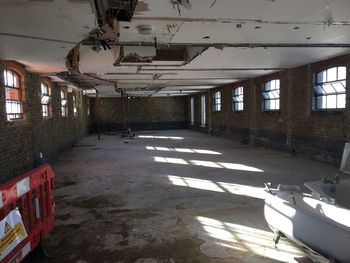Data from a Historic Building Recording at 1-3 Cobourg Street, Camden, Greater London, 2019-2021 (HS2 Phase One)
High Speed Two Ltd., MOLA Headland Infrastructure, 2023. https://doi.org/10.5284/1119004. How to cite using this DOI
Data copyright © High Speed Two Ltd. unless otherwise stated
This work is licensed under a The Open Government Licence (OGL).
Primary contact
High Speed Two Ltd.
2 Snowhill
Queensway
Birmingham
B4 6GA
United Kingdom
Tel: 08081 434 434
Resource identifiers
- ADS Collection: 4382
- DOI:https://doi.org/10.5284/1119004
- How to cite using this DOI
Introduction

This collection comprises reports,digital images, and plans from the historic building recording carried out by MOLA Headland Infrastructure at 1-3 Cobourg Street, Camden, Greater London during 2019 and 2021.
Project Summary
The building record was required to assess and record the character, layout, extent and significance of 1-3 Coburg Street and their setting. The recording was done in accordance with the Historic England Guidelines (HE, 2016), the CIfA guidance (CIfA, 2014), and the Location-Specific Written Scheme of Investigation (LS-WSI; Document number: 1EW02-CSJ-EV-PROS001-000001- Revision P03). The building was recorded to a Level 1-2, in accordance with the Historic England guidelines (HE, 2016). A level 2 recording is defined by Historic England as a descriptive record, made in similar circumstances to Level 1 but when more information is needed.
The building recording was undertaken in accordance with specific guidance produced by HS2, namely the Technical Standard Specification for historic environment investigations (HS2-HS2-EV-STD-000-000035) and the Generic Written Scheme of Investigation: Historic Environment Research and Delivery Strategy (GWSI: HERDS) (HS2-HS2-EV-STR-000- 000015). The project aimed to satisfy the following aims and objectives: To investigate the link between the development of the railways and broader changes in the historic landscape, such as urban settlement expansion and the decline of the canal network. Moreover, identifying key changes in the technology of railway infrastructure and how these changes influence she distribution of goods or the movement of people.
Re-Use Value Statement
This archive provides a comprehensive descriptive, analytical and visual record of 1-3 Cobourg Street, Camden. The archive can provide information for any future research regarding the asset as part of the enabling works of HS2.
This archive can be used independently and/or in in conjunction with the rest of HS2 datasets in order to inform the wider historic building records generated through this project. This can also function as a guide to digital archiving for future infrastructure projects benefiting both the commercial sector and the research community.






